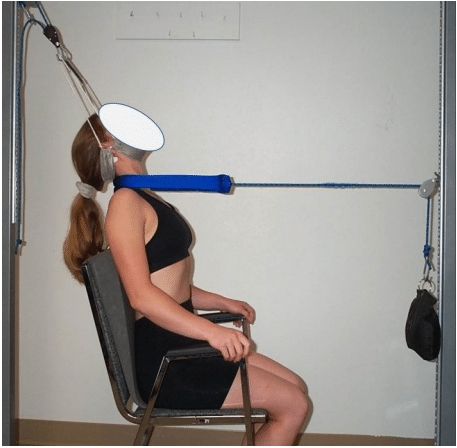Cervical spondylotic radiculopathy (CSR): is one of the most common causes of cervical radiculopathy. It has been documented that the incidence of cervical degenerative abnormalities increases with age having the greatest frequency in the fifth to sixth decade of life. Spondylotic degenerative findings appear to be the most common followed by disc damage and these are most common in the lower cervical spine discs (C5–C6). The degenerative state of the intervertebral disc, vertebral body and adjacent structures, occurs as a result of several factors including segmental injury/trauma and alterations in the sagittal alignment of the cervical spine; including reductions in the segmental and total angle of cervical curvature.
If you are interested in learning more about hydrotherapy, you can read the following books:
NORTH AMERICAN SPINE SOCIETY EVIDENCE-BASED CLINICAL GUIDELINES FOR MULTIDISCIPLINARY SPINE CARE
Study Overview #
The following study ” The Efficacy of Cervical Lordosis Rehabilitation for Nerve Root Function and Pain in Cervical Spondylotic Radiculopathy: A Randomized Trial with 2-Year Follow-Up ” Published in 2 November 2022 and conducted by Ibrahim M. Moustafa, Aliaa A. Diab and Deed E. Harrison

Background #
Sagittal cervical alignment is a clinically related feature in patients suffering from chronic cervical spondylotic radiculopathy (CSR). We designed this randomized trial to explore the effects of cervical lordosis (CL) correction in thirty chronic lower CSR patients with CL < 20◦ . Patients were assigned randomly into two equal groups, study (SG) and control (CG). Both groups received neck stretching and exercises and infrared radiation; additionally, the SG received cervical extension traction. Treatments were applied 3× per week for 10 weeks after which groups were followed for 3 months and 2 years. The amplitude of dermatomal somatosensory evoked potentials (DSSEPS), CL C2–C7, and pain scales (NRS) were measured.
Methods #
the study was A prospective, investigator-blinded, parallel-group, randomized clinical trial and conducted at a research laboratory in our university and was retrospectively registeredwith ClinicalTrials.gov (NCT05547997) accessed on 20 September 2022.
Assessment tools #
the main outcome measure used to assess the nerve root function was the peak-topeak amplitude of dermatomal somatosensory evoked potentials (DSSEPs). An electromyogram device (Tonneis neuroscreen plus version 1.59, Erich Jaeger, Inc., RhedaWiedenbrück, Germany) was used to measure this variable for all patients before starting the treatment, at the end of 10 weeks, at a follow-up of three months, and the long-term follow-up period of two years.
Limitations #
The current study has several limitations, each of which points toward directions of future study. The primary limitations were the lack of investigator blinding and the sample was a convenient sample of patients with CSR rather than a random sample of the whole population. Further, the sample size was just above the minimum number for statistical significance with only 15 participants per group; 14 were needed. Larger sample sizes in future RCTs need to be performed to confirm or refute our findings; specifically, the 2-year follow-up in the control group where the sample size of 12 participants’ data was just under the minimum of 14 needed for robust statistical claims to be made. Ideally, it would have been beneficial to provide a 5-year follow-up of our population to truly understand the impact of cervical curve restoration in the long term. However, due to the smaller sample size of our trial (15 participants in each group), it was not possible to follow our patients past 2-years as we would not have had enough data for statistical analysis. Additionally, in terms of the existing conservative care literature on CSR outcomes in RCTs, it is clear that studies use 1–2 year follow-ups as their definition of ‘long term’. In fact, most CSR RCTs only offer 3-month to 1-year follow-up and it is rare that studies go on for 2 years and longer [2,8–13].
Results #
A significant reduction in NRS for SG after 10 weeks of treatment with nonsignificant loss of change at 3 months and continued improvement at 2 years was found. CG had less significant improvement in post-treatment NRS; the 3-month and 2-year measures revealed significant worsening in NRS. An inverse linear correlation between increased CL and NRS was
found (r = −0.49; p = 0.005) for both groups initially and maintained in SG at the final 2-year follow-up (r = −0.6; p = 0.01). At 10 weeks, we found significant improvements in DSSEPS for both groups (p < 0.0001). We identified a linear correlation between initial DSSEPs and CL for both groups (p < 0.0001), maintained only in the SG at the final follow-up for all levels (p < 0.0001).
Conclusions #
The investigation identified that the correction of the cervical lordosis, in hypolordotic spines of patients suffering from CSR, had improved pain and neurophysiology. The group receiving three-point bending cervical traction attained a significant increase in cervical
lordosis, improvement in their pain intensity, and nerve root function measured with DSSEPs. Follow-up measurement revealed stable improvement in all measured variables.
These observed effects of sagittal curve correction offer insights to clinicians working with patients with cervical spine disorders such as chronic CSR.
Future research #
- Future trials should continue to investigate the rehabilitation of the abnormal cervical curve in CSR populations focusing on larger sample sizes, who are the optimum candidates, what an adequate curve correction is, and longer follow-up time periods
- Biomechanical investigations via computer simulation would be beneficial in future experimental designs to understand the soft tissue deformation and strain/strain effects of three-point-bending extension traction methods for cervical curve restoration in patients with cervical spondylotic radiculopathy
you can Read the Full text below or click here to download as dpf







Great job
Thank you
عمل ممتاز وبحث رائع ومفید لجميع الزملاء